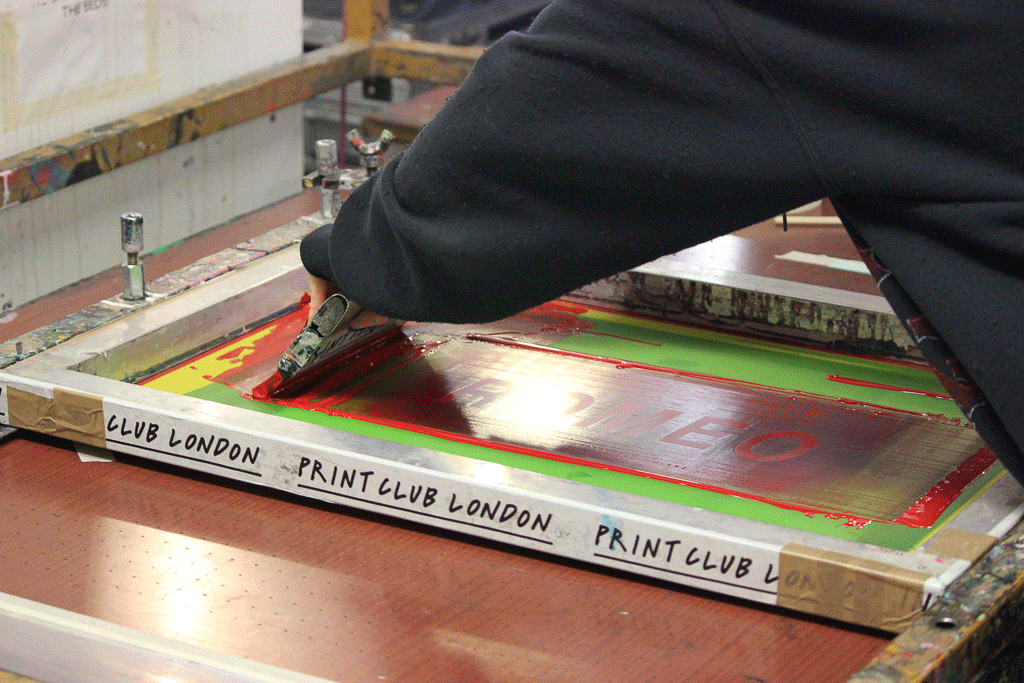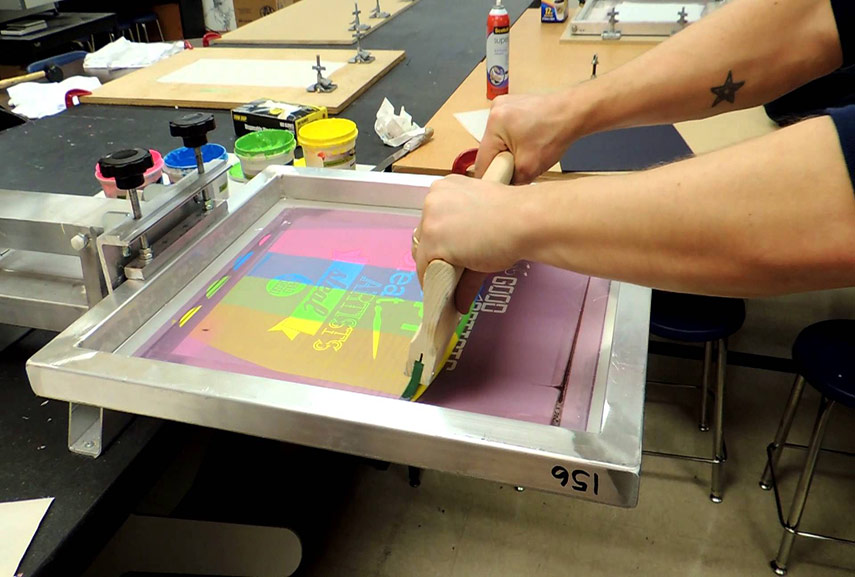ChatGPT said: How to customize your apparel with 10:9 Design Screen Printing in quick turnaround
Discover the Different Kinds of Screen Printing Techniques for Your Following Job
Screen printing provides a varied series of methods that can improve any creative job. From typical approaches like serigraphy to modern-day advancements such as direct-to-garment printing, each technique has its special benefits. Specialized options, consisting of environment-friendly and metal inks, introduce a lot more possibilities. Recognizing these strategies can substantially affect the final result. The obstacle lies in picking the most appropriate approach for certain requirements and preferred results. What aspects should one think about?

The Basics of Screen Printing
Screen printing may seem complex, it is basically an uncomplicated process that involves moving ink through a mesh screen onto various surface areas. The technique starts with the production of a pattern, which specifies the design to be printed. This pattern is connected to a mesh screen, commonly made of polyester or nylon. Once the stencil remains in place, ink is related to the screen and pressed through the mesh utilizing a squeegee, resulting in the wanted pattern being published on the underlying material.
Screen printing can be performed on a variety of substratums, including fabric, paper, and plastic, making it a functional selection for various projects. The procedure permits elaborate styles and dynamic colors, making it preferred in sectors such as art, fashion, and advertising and marketing. Understanding these essentials gears up people with the foundational expertise required to explore advanced strategies in screen printing.
Traditional Screen Printing Techniques
Traditional screen printing strategies have been employed for centuries, maintaining the workmanship and virtuosity of this technique. This approach uses a mesh screen to transfer ink onto a substrate, such as material or paper, enabling vivid and lasting layouts. The process begins with producing a stencil, which blocks specific locations of the screen to manage where the ink will certainly be used.
One prominent method is serigraphy, usually utilized for restricted versions and artistic prints. One more is using water-based inks, which are green and provide a soft feel on textiles - 10:9 Design Screen Printing Texas. Furthermore, traditional techniques can consist of hand-operated printing, where artisans use ink with a squeegee, guaranteeing precision and interest to detail
These strategies remain valued in the market for their responsive quality and the special textures they produce, appealing to both makers and consumers that appreciate the heritage of screen printing.
Digital Screen Printing Innovations
As the need for faster manufacturing and modification in the printing market has actually risen, digital screen printing advancements have emerged as a game-changer. This modern technology blends conventional screen printing methods with electronic processes, permitting for fast prototyping and detailed designs that were previously difficult to accomplish. One significant development is the introduction of direct-to-garment (DTG) printing, which promotes high-quality, full-color prints on various textiles without the demand for screens. Furthermore, developments in ink formulas have actually brought about environment-friendly choices that keep vivid shades while decreasing ecological impact. Making use of automated systems additionally improves production, lowering labor costs and boosting accuracy. These developments not only satisfy tiny batch orders and customized layouts yet also permit for quicker turnaround times, making them ideal for businesses concentrated on conference consumer needs in a fast-paced market. Digital screen printing, as a result, stands for a necessary development in the domain name of printing methods.
Specialized Screen Printing Techniques
Exploring specialty screen printing methods discloses a varied range of techniques that press the limits of creativity and functionality in the printing sector. Amongst these, glow-in-the-dark inks offer a special aesthetic impact, making layouts come active in low-light conditions. Metallic inks, recognized for their shimmering surface, add a touch of deluxe to published materials. One more innovative technique is discharge printing, which eliminates color from the textile as opposed to adding ink, resulting in a soft, vintage feeling. High-density printing develops an increased texture externally, improving tactile involvement. Additionally, water-based inks are getting popularity for their vibrant colors and decreased ecological influence. Each of these specialized techniques provides to specific style demands, allowing musicians and brand names to create standout products that reverberate with their target markets. By leveraging these approaches, businesses can elevate their screen printing jobs to new elevations, ensuring unforgettable impacts.
Eco-Friendly Screen Printing Options
Environment-friendly screen printing options are gaining grip as the sector shifts towards sustainability. Lasting ink options and the usage of biodegradable products are key elements in decreasing the environmental impact of the printing process. By adopting these practices, screen printers can add to a much more sustainable future while maintaining top quality results.
Lasting Ink Choices

Biodegradable Materials Usage
As the screen printing market evolves, the incorporation of biodegradable products is ending up being progressively important for eco conscious practices. Suppliers and designers are currently discovering inks and substrates made from all-natural, sustainable resources that decay much more effectively than conventional equivalents. These naturally degradable options reduce plastic waste and lessen ecological impact, aligning with the expanding demand for sustainable products.
Typical instances include water-based inks and organic cotton textiles, both of which minimize dangerous chemicals and advertise eco-friendliness. Brand names that take on these materials frequently improve their market allure, drawing in consumers that focus on sustainability. As recognition of environmental issues proceeds to climb, the shift towards naturally degradable materials in screen printing is likely to acquire momentum, promoting a greener industry standard.
Picking the Right Strategy for Your Job
Just how can one figure out one of the most appropriate screen printing strategy for a details job? The decision pivots on a number of aspects, consisting of the product to be printed on, the intricacy of the style, and the wanted production quantity - 10:9 Design contact. Direct-to-garment printing is optimal for elaborate layouts with numerous colors, while conventional screen printing succeeds for larger runs of simpler graphics.
In addition, consideration of the end-use of the printed item is necessary. For outdoor applications, techniques that offer longevity and weather condition resistance, such as plastisol ink, may be liked. Conversely, environmentally-conscious jobs may take advantage of eco-friendly products or water-based inks.
Inevitably, comprehending the project's special demands allows for an informed selection, ensuring both aesthetic allure and functional long life. By examining design complexity, material compatibility, and manufacturing scale, one can effectively select one of the most appropriate screen printing method to meet their project's goals.
Frequently Asked Inquiries
What Is the Background of Screen Printing?
Screen printing originated in ancient China around 1000 AD, developing via Japan and Europe. By the 20th century, it became prominent in business art and fashion, revolutionizing exactly how designs were created and dispersed globally.

How Do I Prepare Art Work for Screen Printing?
To prepare artwork for screen printing, one must guarantee high resolution, make use of an appropriate shade mode, produce different layers for every shade, and transform message to lays out, guaranteeing compatibility with the printing process and wanted end result.
What Products Are Ideal for Screen Printing?
The very best materials for screen printing consist of high-grade inks, sturdy screens, and appropriate substratums like cotton, polyester, or blends. In addition, utilizing appropriate solution and mops can boost the for sale sign printing printing process and final results.
Can I Screen Print at Home?
Yes, screen printing in the house is feasible. With the ideal materials, setup, and strategies, people can develop premium prints. Mindful consideration of work area and equipment is crucial for effective outcomes.
What Prevail Errors in Screen Printing?
Common mistakes in screen printing include incorrect exposure times, insufficient ink uniformity, imbalance of displays, not enough cleaning of products, and overlooking to check prints. These errors can endanger the quality and precision of the last product.
Screen printing might seem complicated, it is basically a straightforward procedure that involves moving ink via a mesh screen onto numerous surface areas. As the demand for faster production and customization in the printing industry has risen, digital screen printing advancements have actually emerged as a game-changer. Checking out specialty screen printing methods exposes a diverse selection of methods that push the limits of creative thinking and performance in the printing sector. The ideal materials for screen printing include top quality inks, durable displays, and suitable substrates like cotton, polyester, or blends (10:9 Design Screen Printing). Common mistakes in screen printing include improper exposure times, poor ink uniformity, imbalance printing signages of screens, not enough cleaning of materials, and neglecting to test prints